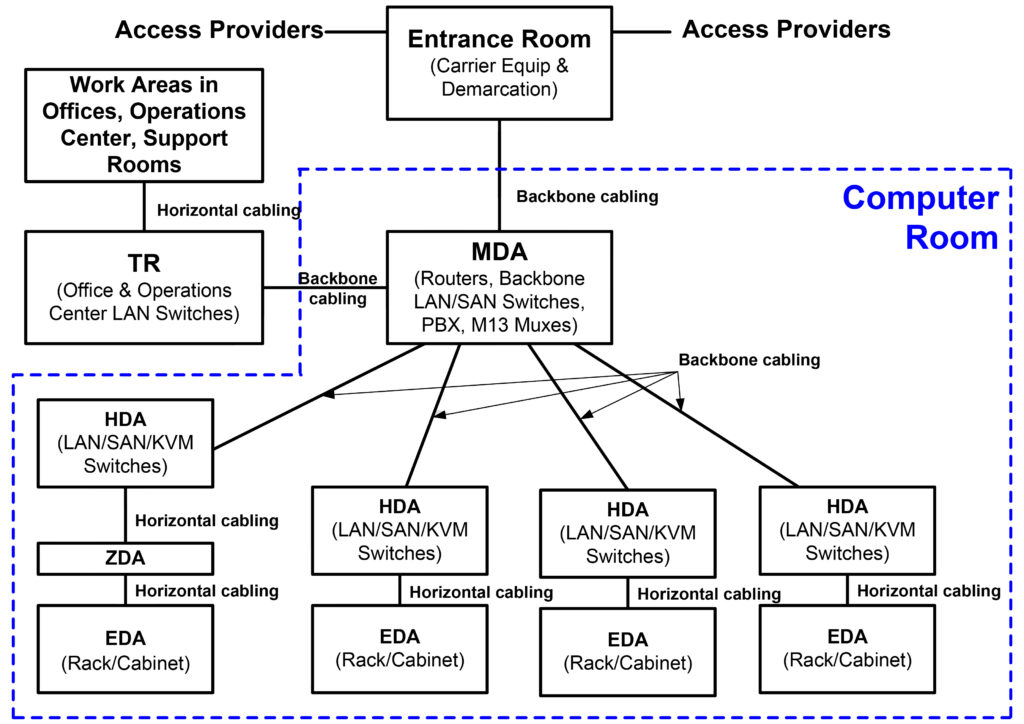ANSI/TIA-942-B: Telecommunications Infrastructure Standard for Data Centers
ANSI/TIA-942-B “Telecommunications Infrastructure Standard for Data Centers” was developed by the TIA TR‑42.1 Premises Telecommunications Infrastructure Subcommittee and published in July, 2017.
Scope: This Standard specifies the minimum requirements for telecommunications infrastructure in data centers and computer rooms, including single tenant enterprise data centers and multi-tenant data centers. Data centers may serve the private domain (e.g., “enterprise” data centers) or the public domain (e.g., internet data centers, co-location data centers, and other service provider data centers). The topology specified in this Standard is intended to be applicable to any size data center in either domain.
Significant changes from the previous edition include:
- MPO‑32 (ANSI/TIA‑604‑18) and MPO‑24 (ANSI/TIA‑604‑5) connectors added as options for termination of more than two fibers (in addition to the MPO‑12 connector)
- Category 8 added as an allowed type of balanced twisted‑pair cabling
- The recommendation for category 6A balanced twisted‑pair cabling changed to category 6A or higher performing balanced twisted‑pair cabling
- OM5 added as an allowed and recommended type of multimode fiber cabling
- 75‑ohm broadband cabling (as specified in TIA‑568.4‑D) added as an allowed media type
- Recommendation to not install optical fiber cords and cables (both bend insensitive and non‑bend insensitive) without adequate armoring or sufficiently thick jacket in pathways that can create microbends (e.g., non‑continuous cable supports, wire basket trays, and cable ladders without radiused cable supports or solid bottoms) added
- Quantity of convenience outlets required on computer room walls reduced
- Local fire protection codes may be used instead of NFPA 75
- Power for air conditioning systems and controls in computer rooms and entrance rooms should be redundant, but does not need to be powered from the same PDUs or panel boards that serve ICT equipment in the room
- The recommended maximum cable length for direct attach cabling in EDAs has been reduced from 10 m (33 ft) to 7 m (23 ft) and the use of direct attach cabling between rows is not recommended
- Recommendation that cabinets be at least 1200 mm (48”) deep and to consider cabinets wider than 600 mm (24”) added
- Recommendation to consider pre‑terminated cabling to reduce installation time and improve consistency and quality of terminations added
- Recommendation to consider needs for proper labeling, cable routing, cable management, and ability to insert and remove cords without disrupting existing or adjacent connections added
- Normative reference to ANSI/TIA‑5017 regarding physical security for the data center telecommunications infrastructure added
- Normative reference to ANSI/TIA‑862‑B regarding requirements for cabling for intelligent building systems including networked data center electrical, mechanical, and security equipment added
- Reference to TIA TSB 162‑A for guidelines regarding cabling for wireless access points in data centers added
- Reference to TIA TSB‑5018 for guidelines regarding cabling for distributed antenna systems in data centers added
- Reference to TIA TSB‑184‑A for guidelines regarding power delivery over balanced twisted‑pair cabling added
- Numerous changes to the rating tables in Annex F, including those that specify concurrent maintainability for Rating‑3 (formerly Tier 3) and fault tolerance for Rating‑4 (formerly Tier 4), made
- Content of TIA‑942‑A‑1 (Cabling Guidelines for Data Center Fabrics) incorporated
ANSI/TIA-942-B Content:
- Data Center Design Overview
- Data Center Cabling System Infrastructure
- Data Center Telecommunications Spaces and Related Topologies
- Data Center Cabling Systems
- Data Center Cabling Pathways
- Data Center Redundancy
- Cabling Installation Requirements
- Cabling Transmission Performance Requirements
- Cabling for Intelligent Building Systems
- Cabling for Wireless Access Points
- Cabling for Distributed Antenna Systems
- Power Delivery over Balanced Twisted-Pair Cabling
- Grounding and Bonding
- Firestopping
- Physical Security
- Administration
- Annexes addressing Cabling Design Considerations, Access Provider Information, Coordination of Equipment Plans with Other Engineers, Data Center Space Considerations, Data Center Site Selection and Building Design Considerations, Data Center Infrastructure Rating, Data Center Design Examples, and Cabling Guidelines for Data Center Fabrics
ANSI/TIA-942-B Example of a Basic Data Center Topology:

ANSI/TIA-942-B Data Center Infrastructure Rating:
This Standard specifies four ratings related to the resiliency of the data center facility infrastructure. Higher ratings not only correspond to higher resiliency, but also lead to higher construction costs. In all cases, higher ratings are inclusive of lower level requirements unless otherwise specified. The key subsystems of the data center resiliency rating are: telecommunications, electrical, architectural infrastructure, and mechanical infrastructure.
Rated‑1 Data Center: Basic
A Basic data center is susceptible to disruptions from both planned and unplanned activity on the distribution path and/or equipment (e.g., building power shutdown, maintenance/failure of a distribution path, or maintenance/failure of equipment). Rated‑1 data centers have a single path for distribution of power, cooling, and telecommunications.
Rated‑2 Data Center: Redundant Component
A Redundant Component data center is susceptible to disruptions from both planned and unplanned activity on the distribution path (e.g., building power shutdown or maintenance/failure of a distribution path). Rated‑2 data centers have component/equipment redundancy and a single path for distribution of power, cooling and telecommunications.
Rated‑3 Data Center: Concurrently Maintainable
A Concurrently Maintainable data center is able to handle planned maintenance on any part of the distribution path or any single piece of equipment or component without causing interruption to the data center operations. Rated‑3 data centers have, at a minimum, one active (N) and one standby (+1) path for distribution of power, cooling, and telecommunications.
Rated‑4 Data Center: Fault Tolerant
A Fault Tolerant data center is able to handle planned maintenance or a single fault on any part of the distribution path or any single piece of equipment or component without causing interruption to the data center operations. Rated‑4 data centers have, at a minimum, dual active (2N / N+N) paths for distribution of power, cooling, and telecommunications.
Back to the FOTC TIA Standards Explorer
